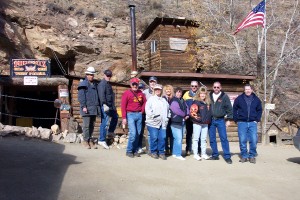
Audie (miner) and GPR members at
Phoenix Gold Mine (west portal)
photo by Dick Oakes
The Gold Prospectors of the Rockies went on an outing to the Phoenix Mine in Idaho Springs, Clear Creek County, Colorado, on Saturday, October 25, 2003. Members attending were Ken Barker, Shawn & Pinie Conell (who arranged the tour), Joe Johnston, Dick & Carol Oakes, Rose Stewart, Doug Taylor, Mike & Yvonne Weidman, and Larry & Shirley Weilnau.
The mine, located on Trail Creek at 8,200 feet in elevation, is a working gold and silver mine owned and operated by third-generation hard-rock miner Alvin "Al" Mosch. As we found out, the mine's temperature hovers between 42 and 54 degrees F. year round, so it's good to wear a jacket no matter what month you arrive, as Al's tour can last from one to two hours! Miners still push tons of gold and silver ore along the narrow-gauge rails in small underground ore cars, just as they did 150 years ago. Because this is a working mine that caters to others interested in mining, be sure to wear sturdy shoes. You are welcome to bring your still and video cameras, too!
 at the shack |
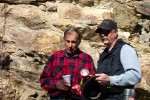 and Mike (miner) |
 at east portal |
The Phoenix Gold Mine has some interesting history. In 1871, a vein was discovered 1,000 feet west and above the current Phoenix location by a man whose last name was, appropriately, Miner. The man sold the claim to two Cornwall, England, miners who found someone to grubstake them and buy the mine for $5,000.00. They started mining the drift up where I-70 is now and went 1,000 feet--all by hand steel. Nothing of much value was found and the grubstaker was getting nervous and thinking about getting out so the two miners took him to the Buffalo Bar and eventually talked him into investing more money. They went another 1,000 feet and struck it rich. They worked the mine until World War I, when they retired and returned to Cornwall because of a shortage of supplies to work the mine.
Al's grandfather, Rudolf Gerhardt von Mosch, left Germany in 1881 at age 17 to come to the States. During World War I, he was known as George Marsh (he felt the name Rudolf Gerhardt was too German for the times in the U.S.). He then changed his name to George Mosch after the war.
Grandfather George also was a constable, making the family one with the longest law enforcement history around. For more than 50 years, George arrested folks but never once put anyone in jail. He arrested men by sticking a 6-shooter in their backs, having them raise their hands, and then marching them up to ten miles to Tolland where he usually fed them, visited with them over whiskey through the night, then turned them loose in the morning with money and the advice that they change their ways. George never drove and rarely rode a horse. He spoke seven languages by the time he was 17 years old. At the age of 87, George walked five miles from Tolland to Rollinsville to catch the train to a Denver hospital.
George led in the 1st survey of the Moffat tunnel near James Peak and the Gold Run mine. He worked at Solomon's Bar & Grill in Denver for a while where he met indigent Horace Tabor after Tabor went broke. George died in 1952 at the age of 87.
 Al's dad, Hans, worked at the Bobtail Mine at Central City and the likeness of his Aunt Elsie became the Face on the Bar Room floor of the Teller House in Central City. Al's aunt Mattie, married to Han's brother Walt, was much loved in Central City as she nursed several people back to health when most doctors and nurses left the area. Mattie later sang in bars. Al's uncle Walt worked in Central City's Boodle Mine and his Uncle Rudy also worked in the local mines.
Al's dad, Hans, worked at the Bobtail Mine at Central City and the likeness of his Aunt Elsie became the Face on the Bar Room floor of the Teller House in Central City. Al's aunt Mattie, married to Han's brother Walt, was much loved in Central City as she nursed several people back to health when most doctors and nurses left the area. Mattie later sang in bars. Al's uncle Walt worked in Central City's Boodle Mine and his Uncle Rudy also worked in the local mines.
In 1930, the mine was sold in a tax sale to an Idaho Springs real estate man for $20.00. The agent "salted" the mine by firing a shotgun loaded with gold into the dirt and sold it to a family of two Minnesota farmers named Gunderson for $5,000. They went 30 to 40 feet further along the drift and struck ore. They went down 100 feet and the vein was 11 feet wide. They were getting a high output of 6 ounces of gold per ton of ore. Then, in 1934, the government devalued the dollar which raised the price of gold in the area from $20.00 to $35.00 per troy ounce. Bonanza!
 In 1943, President Franklin Delano Roosevelt closed all gold and silver mines to divert miners to mining minerals needed for the war effort. After World War II, only a few mines re-opened. Gold was still valued at $35.00 an ounce but was costing a much higher amount an ounce to process. Small miners, such as Al Mosch, had a rough time of it. The closest mill and assay office was in Montana. In 1960, the Guggenheim's Leadville smelter, the last in the west, was dismantled. Now, the closest smelter is in British Columbia. Small miners don't ship ore anymore as it is too expensive. They process their ore themselves. The Phoenix Mine has a mill of its own just outside the mine entrance portals.
In 1943, President Franklin Delano Roosevelt closed all gold and silver mines to divert miners to mining minerals needed for the war effort. After World War II, only a few mines re-opened. Gold was still valued at $35.00 an ounce but was costing a much higher amount an ounce to process. Small miners, such as Al Mosch, had a rough time of it. The closest mill and assay office was in Montana. In 1960, the Guggenheim's Leadville smelter, the last in the west, was dismantled. Now, the closest smelter is in British Columbia. Small miners don't ship ore anymore as it is too expensive. They process their ore themselves. The Phoenix Mine has a mill of its own just outside the mine entrance portals.
In 1972, Al bought the Phoenix for that magic number of $5,000.00. At the time, he was working as a silver miner (prior to that, he had worked at the Climax Molybdenum Mine and mines in Utah). Al has since done a lot of "dead work," greatly adding to the workings, creating tunnels, blasting stopes, installing support beams, laying track, etc. In order to have the road up Trail Creek widened, Al donated some of his land to the county and reconstructed the mine buildings.
Al's mother, Betty, using a dowser's divining rod, located a vein 50 feet from the Phoenix vein and Al began working on what he called the "Resurrection" vein. The money gained from the Resurrection helped finance extending the old Phoenix Gold Mine workings. The aqua-colored Resurrection vein is very evident in the ceiling of the Shaker Table and Ball Mill rooms. The coloration is from copper oxidation.

vein |
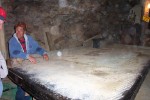
shaker table |
The Mosch family is one of the longest continuous mining families in Colorado, from Rudolf (George) to Hans to Al, and now to Al's son David. As a 15-year-old, David learned about blasting when he blasted a road for a neighbor who paid him with an old pickup truck. Before becoming a mining engineer, David had many years of practical mining and underground construction experience. With his family, David has operated several mines in Colorado. He became a professor at the Colorado School of Mines in 1997. His specialties include mine safety, blasting operations, mine planning, and mineral economics. His primary responsibility with the department is as manager of the Edgar Experimental Mine in Idaho Springs. The Experimental Mine is used to instruct mining engineering students in practical aspects of mining engineering, such as drilling, blasting, equipment operation, equipment maintenance, haulage logistics, and mine ventilation.
In the mine you'll find "The Widow Maker," a 150-pound compressed-air-powered, one-man rock drill that was just about guaranteed to kill its user after three years of use prior to the use of water to cut the dust that caused silicosis of the lungs. Silicosis killed Al's Uncle Walt. Inside the west entrance portal you can see an ore car and view an advertising board for the Union Mining & Leasing Corporation. These boards were popular in the late 1800s and early 1900s to show their workings, buildings, and samples of their ore, all in one exhibit. While at the mine, enter an adit. Feel country rock. Walk on a foot wall. Look up a stope. Look down an incline winze. Skirt a cavein. Dodge an ore chute. Spy a R.I.P. marker. Peer into a forbidden zone. Veer into a drift. Dig into a filled ore cart. Behold a vein of gold ore. See a ball mill. Watch a jaw crusher. Come face to face with a face. Hang out with the gangue. Watch out for a grizzly. Join the reserves. Duck a hanging wall. Locate a trend. Observe a shaker table. But wait--there's more (I just can't find my thesaurus).
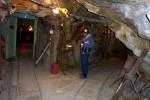 at the wye |
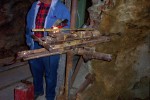 "Widow Maker" |
 crusher (foreground) |
 (read caption) |
Al Mosch is an acomplished storyteller who personalizes your tour experience. One story was about the visit by members of the Vatican, including 30 high bishops and a cardinal. The cardinal blessed the mine when he found out Al plans to create a museum and donate the proceeds to handicapped children. Then there is another story about slave nuns . . . but we'll let Al tell you about them when you go to the mine yourself! We learned about the gold milling and refining process, listened for Tommyknockers (a.k.a Tommy-Knawkers), and kissed the mine's "Lucky Bucket." The Lucky Bucket has several stories of its own surrounding it about hundrreds of people who rubbed or hugged or kissed it, had phenomenal good luck, and wrote Al about it. Al asks that all who touch the bucket send him their good-luck stories.

"Lucky Bucket" |
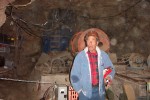 (solar batteries at left rear) |
Al has converted the lighting of the Phoenix to solar-powered electricity, having installed 18 solar panels on the mountain above the mine portals. If Al can do it, surely other mines and businesses can become more environmentally responsible!
Encouraged to set his stories down in writing, Al has written three books (so far): Legend of the Silver Senator, Hot Rock Derelicts, and The One Hundred Dollar Bill. The first volume is 125 pages and the latter two have been combined into a single volume of 137 pages. Both volumes are available for purchase at the mine (he autographed them for us, too!). Also in the works are Beth Simmons' release of Al's biography and John Eastman's collaboration with Al on some of his fiction books. Jo Petit is working on a book titled A Walk in Al's Shoes, which was due out in December of 2002 but has not been completed.
 TV's Unsolved Mysteries has filmed at the Phoenix Gold Mine and a new movie due out in 2004, titled Silver City, was lensed in the interiors of Al's mines in September, as well as in Evergreen, in Leadville, and in downtown Denver. Reported to be in the cast, along with star Daryl Hannah, are Maria Bello, Thora Birch, David Clennon, Chris Cooper, Richard Dreyfuss, Denver Mayor John Hickenlooper, Danny Huston, Kris Kristofferson, Denis Leary, Cheech Marin, and Billy Zane. It is being directed by John Sayles and is being produced by Maggie Renzi, John's wife of 20 years! The plot thickens around a political drama/murder mystery that tells the story of a small town in Colorado and the events leading up to a local election, including the discovery of a man's body in a local lake. Filming was to have been wrapped up by October 31. Check the Internet to view the movie's trailers when they're available!
TV's Unsolved Mysteries has filmed at the Phoenix Gold Mine and a new movie due out in 2004, titled Silver City, was lensed in the interiors of Al's mines in September, as well as in Evergreen, in Leadville, and in downtown Denver. Reported to be in the cast, along with star Daryl Hannah, are Maria Bello, Thora Birch, David Clennon, Chris Cooper, Richard Dreyfuss, Denver Mayor John Hickenlooper, Danny Huston, Kris Kristofferson, Denis Leary, Cheech Marin, and Billy Zane. It is being directed by John Sayles and is being produced by Maggie Renzi, John's wife of 20 years! The plot thickens around a political drama/murder mystery that tells the story of a small town in Colorado and the events leading up to a local election, including the discovery of a man's body in a local lake. Filming was to have been wrapped up by October 31. Check the Internet to view the movie's trailers when they're available!
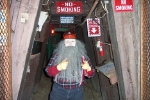 In two of Al's mines, ghosts have been seen--most notably an old miner who has been seen by several people in both mines, as well as unexplained touches on the shoulder or hair, etc. These experiences convinced Al to conduct his Ghost Mine Tours around Halloween each year. This year, GPR members helped out by being ghosts, ghouls, and a Tommyknocker! They were Dick & Carol Oakes (Dick was the Tommyknocker), Mike & Yvonne Weidmann, and Larry & Shirley Weilnau, as well as Larry & Shirley's son Steve and his fiancé Erin.
In two of Al's mines, ghosts have been seen--most notably an old miner who has been seen by several people in both mines, as well as unexplained touches on the shoulder or hair, etc. These experiences convinced Al to conduct his Ghost Mine Tours around Halloween each year. This year, GPR members helped out by being ghosts, ghouls, and a Tommyknocker! They were Dick & Carol Oakes (Dick was the Tommyknocker), Mike & Yvonne Weidmann, and Larry & Shirley Weilnau, as well as Larry & Shirley's son Steve and his fiancé Erin.
For the enthusiast, the price of the mine tour includes an opportunity to try your hand at gold panning (gold pans are provided) in the stream that runs through the mine property. There are also picnic tables and barbecue pits alongside the stream. Stroll the property and view the many pieces of old mining equipment. Nature lovers can spend the day in the beautiful Alps Mountain area on Trail Creek. Ghost towners can travel up the creek to the ghost town locations of Freeland and Lamartine.
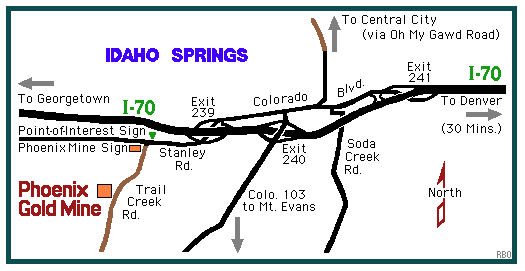
The Phoenix Gold Mine is open year round, weather permitting (call for closures), at 834 County Rd. 136 (Trail Creek Rd.). Mail to: PO Box 3236, Idaho Springs, CO 80452-3236. Telephone: 303/567-0422 (fax 303/567-9222). Open 10:00 a.m. daily to 6:00 p.m. from April through October and to 4:00 p.m. from November through March. Tours cost $5.00 for children, $10.00 for folks 12 and over, $8.00 for seniors, and free for severely handicapped. School group discounts are available. Participation only in the gold panning experience is $5.00. Reservations requested for groups over 20. For more information, point your browser to the official website at http://www.phoenixmine.com/, created and maintained by Al's cousin Walter Richards' son, Lyle Richards. Another website is at http://www.phoenixgoldmine.com/.